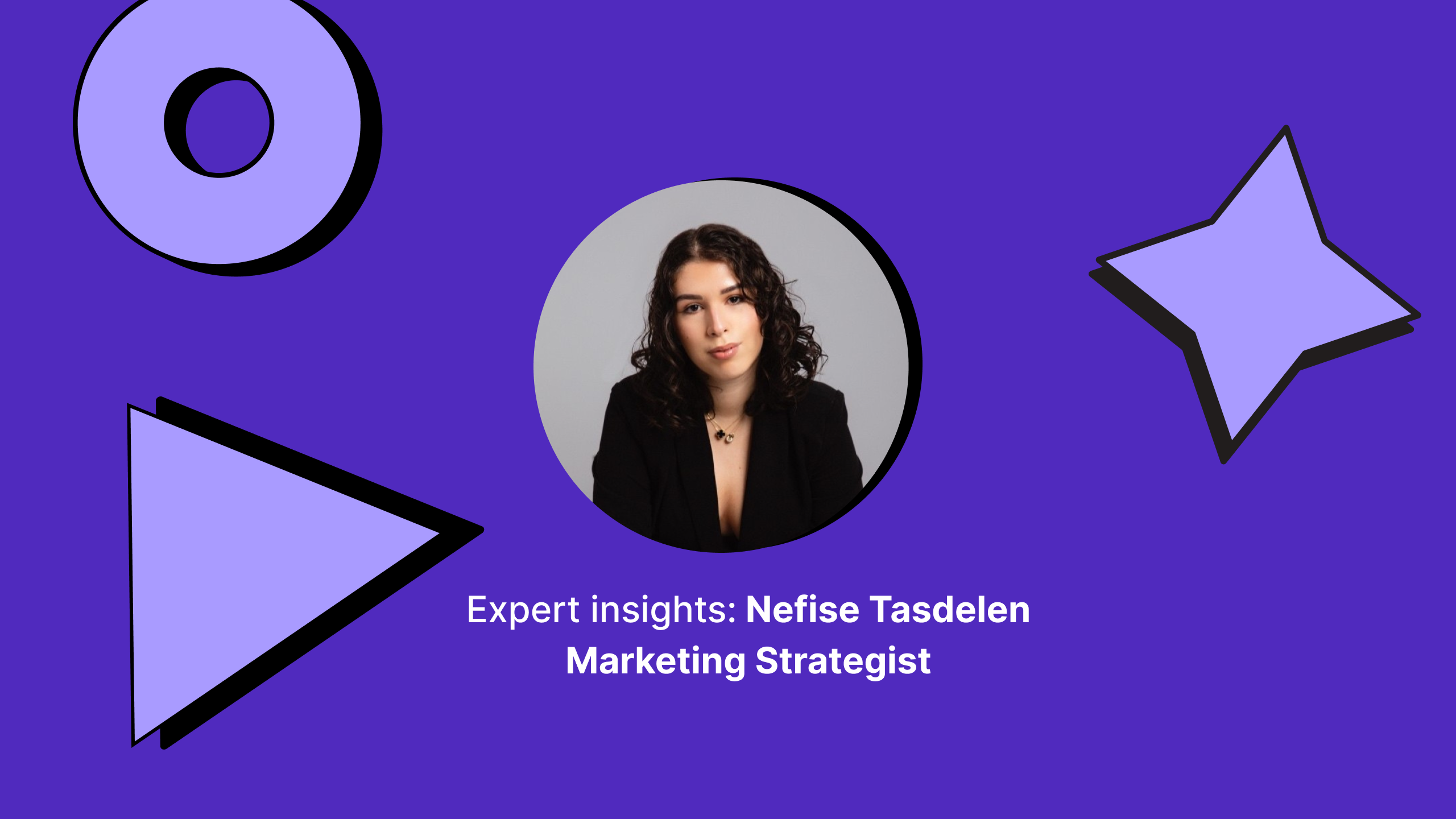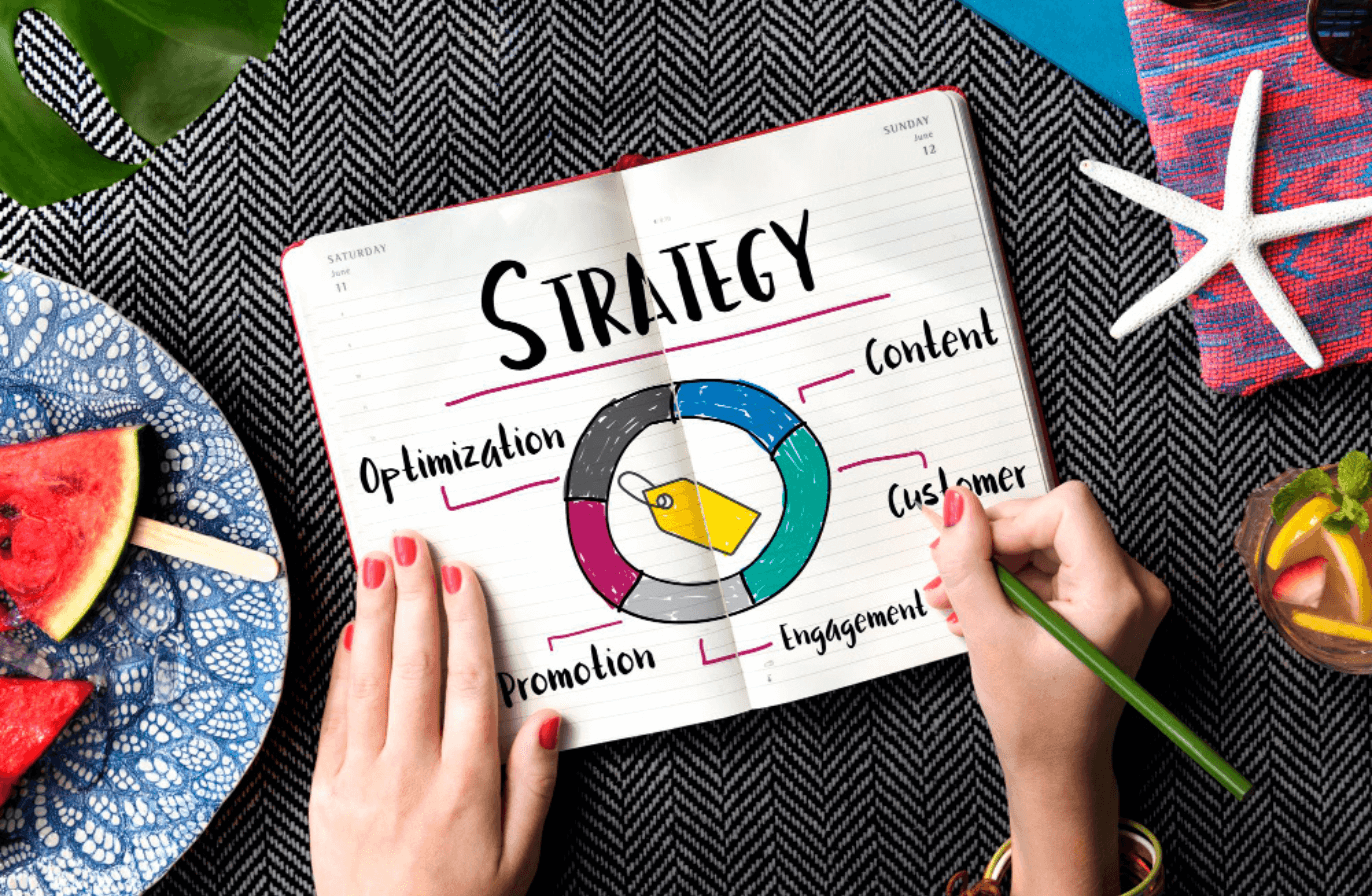13 Strategies For Success In B2B Social Media Marketing
Discover how to manage B2B social media marketing through tested strategies and tips that will help you elevate your brand on social.

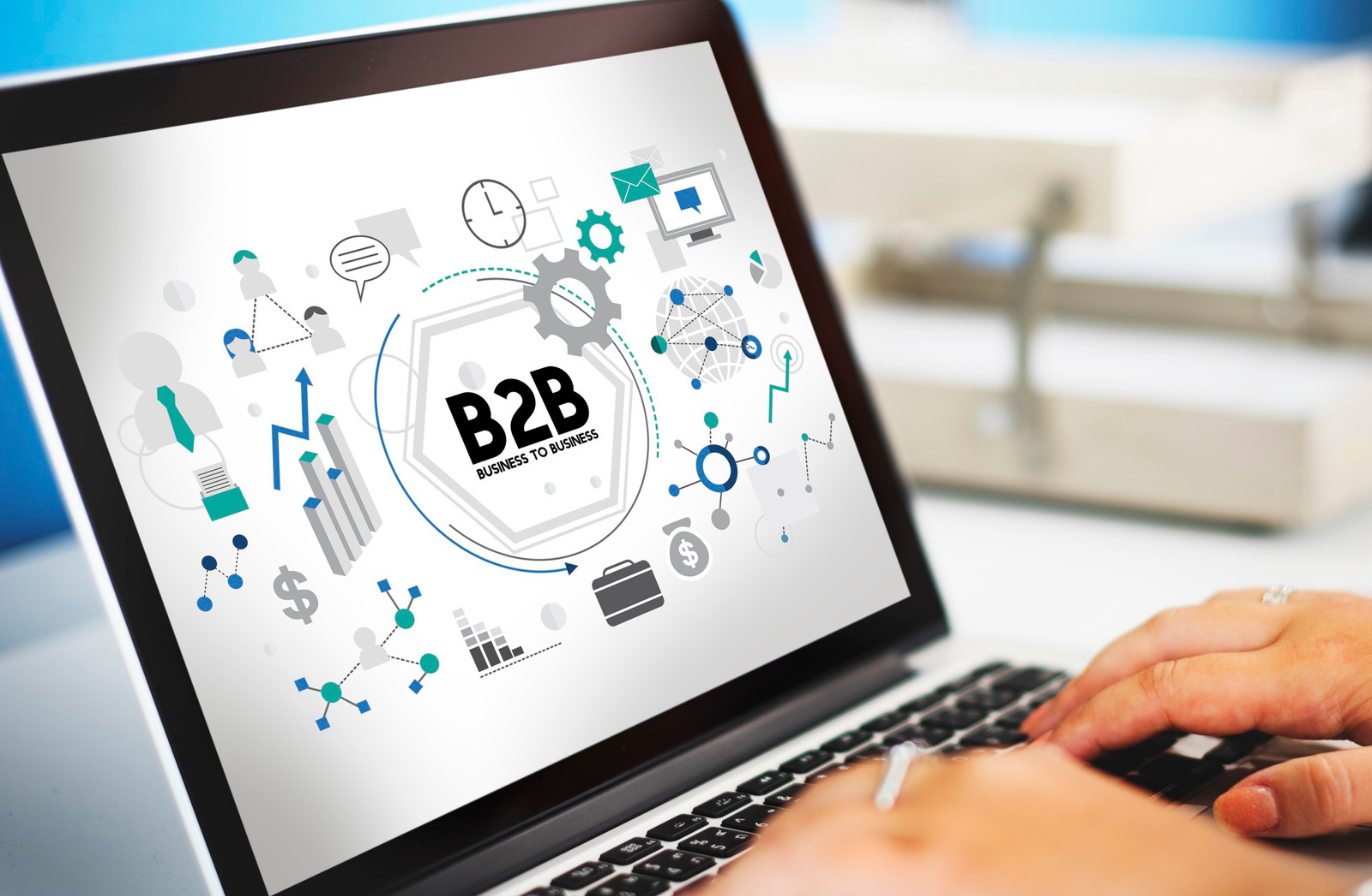
B2B brands can no longer afford to treat social media as an afterthought. A sharp social media strategy turns platforms like LinkedIn and X into powerful tools for building trust, sparking conversations, and driving conversions. The key? Delivering value-driven, hyper-relevant content that speaks directly to your audience’s needs.
Smart social media marketing isn’t about vanity metrics—it’s about precision. From targeted campaigns to data-backed storytelling, it’s your ticket to standing out in a crowded feed and closing deals faster. Let’s explore how to make it work for your business.
What is B2B social media marketing?
B2B social media marketing entails using social media platforms to market products or services to other businesses. It involves creating and sharing content, engaging with business decision-makers, and building professional relationships that lead to deals and partnerships.
When we talk about social media for B2B, we're looking at a strategic approach where businesses:
- Showcase their expertise to decision-makers;
- Build trust with potential clients;
- Share valuable industry insights;
- Connect with multiple stakeholders in the buying process.
While B2C social media also aims to get sales (ultimately), it's targeted at individual consumers and more geared towards providing entertainment and getting quick wins.
B2B social media strategies, on the other hand, focus on demonstrating authority, solving complex business problems, and nurturing long-term relationships through platforms like LinkedIn, Facebook, and Instagram.
Best social media platforms for B2B marketing
Some social media platforms are naturally a better fit for the B2B space, like LinkedIn, which provides access to a huge professional network.
But don't discard others, like Facebook or TikTok, as they might surprise you and bring you unexpected results — when used strategically.
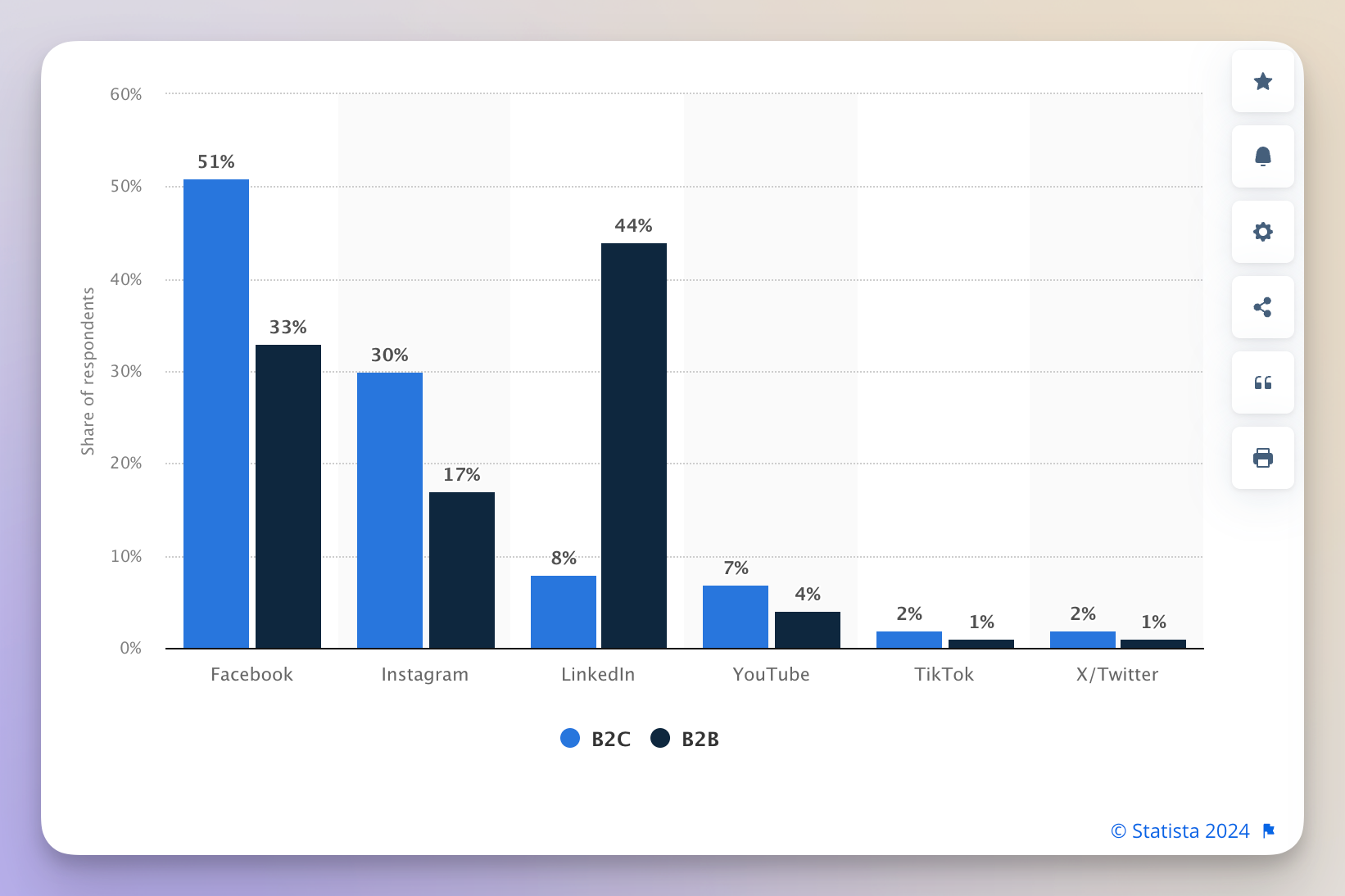
Here are the top B2B social media platforms with tips for social media managers on how to use them effectively.
LinkedIn for B2B lead generation
LinkedIn is the most effective social media platform for B2B, with 85% of marketers saying it delivered the best value for their company in 2024, according to The Content Marketing Institute.
Other studies also consistently found the platform to be very efficient for B2B business, especially for driving high-quality leads, with 89% of B2B marketers using LinkedIn for lead generation and 62% saying it produces leads for them.
Here's how to do LinkedIn marketing for B2B effectively:
- Share thought leadership content and industry insights;
- Post company updates and case studies;
- Engage with industry leaders and prospects through comments and groups;
- Use LinkedIn Live for virtual events and product demonstrations;
- Use LinkedIn Sales Navigator for lead generation.
Insider tip: The LinkedIn algorithm favors posts that generate quick engagement. Share your content when your target audience is most active, and be quick to reply to comments.
Instagram for high engagement
While traditionally B2C-focused, Instagram has become increasingly valuable for B2B marketing.
In fact, research has found Instagram to be better at generating engagement for B2B businesses than other platforms, including LinkedIn — so it might serve your top-of-funnel social media goals better.
Here's how to use Instagram for B2B effectively:
- Share behind-the-scenes content about your company culture;
- Create infographics and carousels with engaging facts and figures;
- Use Instagram Stories to cover industry events;
- Showcase your team in an authentic way;
- Leverage Reels for quick educational content.
Insider tip: Use visually appealing educational content as a teaser for more in-depth resources that can serve as lead-generation mechanisms.
Facebook for high social media ROI
Facebook remains relevant for B2B marketing due to its massive user base and advanced targeting features.
According to a 2023 survey, B2B marketers considered Facebook the social media channel with the highest return on investment. Naturally, Facebook has a well-deserved spot in the top 3 social media platforms to use for B2B marketing.
Here's how to use Facebook for B2B effectively:
- Share company news and updates;
- Post industry-relevant content;
- Use video content to explain complex products;
- Leverage Facebook Live for product launches.
Insider tip: Create custom audiences based on website visitors who spent time on specific product pages, then serve them targeted content about those solutions.
Facebook Groups for B2B community building
Facebook Groups deserve a special mention after the parent platform as they offer unique opportunities for B2B networking.
Given the often private nature of Facebook Groups, it's difficult to extract engagement statistics. However, given that 1.8 billion people use Facebook Groups every month and that Facebook has a wide demographic pool, you're likely to be able to reach audience segments that might be more difficult to engage somewhere else.
Also, Meta is constantly adding more features to help brands engage better with audiences, such as Group AI to help members of groups find answers to their questions.
Here's how to use Facebook Groups for B2B effectively:
- Create industry-focused discussion groups;
- Be active daily in the groups you own to post content or answer comments;
- Share exclusive content and offers with group members;
- Join industry groups and participate in discussions;
- Post highly useful content that answers people's questions.
Insider tip: Set up weekly themed discussions in your group. For example, "Introduce yourself Monday" or "Success story Friday" to maintain consistent engagement.
X (formerly Twitter) for real-time B2B engagements
X remains one of the top social networks worldwide in 2024 by number of monthly active users, sitting at number four after Facebook, YouTube, Instagram, and WhatsApp.
Despite various controversies surrounding the platform in recent years, X continues to provide immediate engagement opportunities for B2B brands and should complement their presence on the above-mentioned platforms.
Here's how to use X for B2B effectively:
- Share fun and interesting industry news and commentary;
- Engage and add value to relevant conversations;
- Live-tweet from industry events;
- Provide customer support;
- Use an authentic, conversational tone of voice.
Insider tip: Create a private X list of your key accounts, competitors, and industry leaders. Check it daily for engagement opportunities that won't get lost in the main feed.
YouTube for B2B discoverability and thought leadership
You know it by now: video is king, and YouTube is the king of video (we see you TikTok, but you're not still there).
YouTube's value for B2B content continues to grow, given that 95% of B2B buyers agree that video influences their purchase decisions. Moreover, B2B marketers using video in their strategy grow their brand's revenue 49% faster than companies not using video.
Here's how to use YouTube for B2B effectively:
- Create useful product demonstrations and tutorials;
- Share expert interviews and webinar recordings;
- Develop educational series about your industry;
- Post customer testimonials and case studies;
- Leverate YouTube Shorts to attract people to your longer educational videos.
Insider tip: Add timestamps to longer videos in the description to create chapters and key moments. B2B decision-makers often want to jump directly to relevant sections.
TikTok for expanding B2B reach
While newer to the B2B space, TikTok shows promising potential and social media marketers are here for it.
A 2023 survey showed that 61% of B2B marketers are using TikTok mostly to reach wider audiences — including younger groups that may not use some of the platforms already mentioned that much.
Here's how to use TikTok for B2B effectively:
- Share quick tips and industry insights;
- Showcase company culture in an authentic way;
- Create educational content in an engaging format;
- Keep an eye on social media trends and jump in when relevant.
Insider tip: Use TikTok's Q&A feature to create an FAQ series about your industry. This format performs well and creates valuable, reusable content.
Don't try to be present on every platform at once. Start with LinkedIn as your primary channel, then expand to 2-3 additional platforms based on where your specific B2B audience spends their time. Monitor social media analytics to refine your platform strategy over time.
13 proven B2B social media strategies for 2025
Now that we discussed the basics of B2B social media marketing for each platform, let's discuss specific strategies that can be applied across channels.
These proven methods come from analyzing successful B2B brands and understanding what drives real engagement based on data and experience.
While each can be implemented individually, they work best as part of an integrated B2B social media strategy.
#1. Define your B2B social media goals
Every successful B2B social media strategy starts with clear, measurable goals.
Setting specific objectives helps you create targeted content and measure your success effectively, while overcoming common social media marketing challenges such as lack of focus, consistency, and ROI.
How to define your goals:
Select your primary objectives, aligned with overall marketing goals:
- Engagement: "Increase LinkedIn comment rates by 25% in Q1."
- Lead generation: "Generate 20 qualified leads per month."
- Thought leadership: "Establish executive presence through weekly content."
- Brand awareness: "Grow industry hashtag mentions by 30%."
Prioritize and focus your efforts for maximum impact of social media on business:
- Select a maximum of two to three primary objectives;
- Strive to help solve current business challenges;
- Plan content themes around chosen goals.
Create frameworks to be able to measure progress:
- Choose specific metrics for each goal;
- Set up tracking systems and dashboards;
- Establish a monthly review schedule.
Insider tip: Review your social media goals quarterly. What worked last quarter might need adjustment as your business grows or market conditions change.

#2. Choose the right platforms for your business
Making smart platform choices is crucial for B2B social media managers who want to get results.
Instead of trying to be everywhere, focus your efforts where your audience actually spends their time and where your content can make the biggest impact.
How to select your platforms:
Perform a social media audit to understand your current presence:
- Measure engagement on existing platforms;
- Identify where your target audience is most active;
- Analyze which content types perform best.
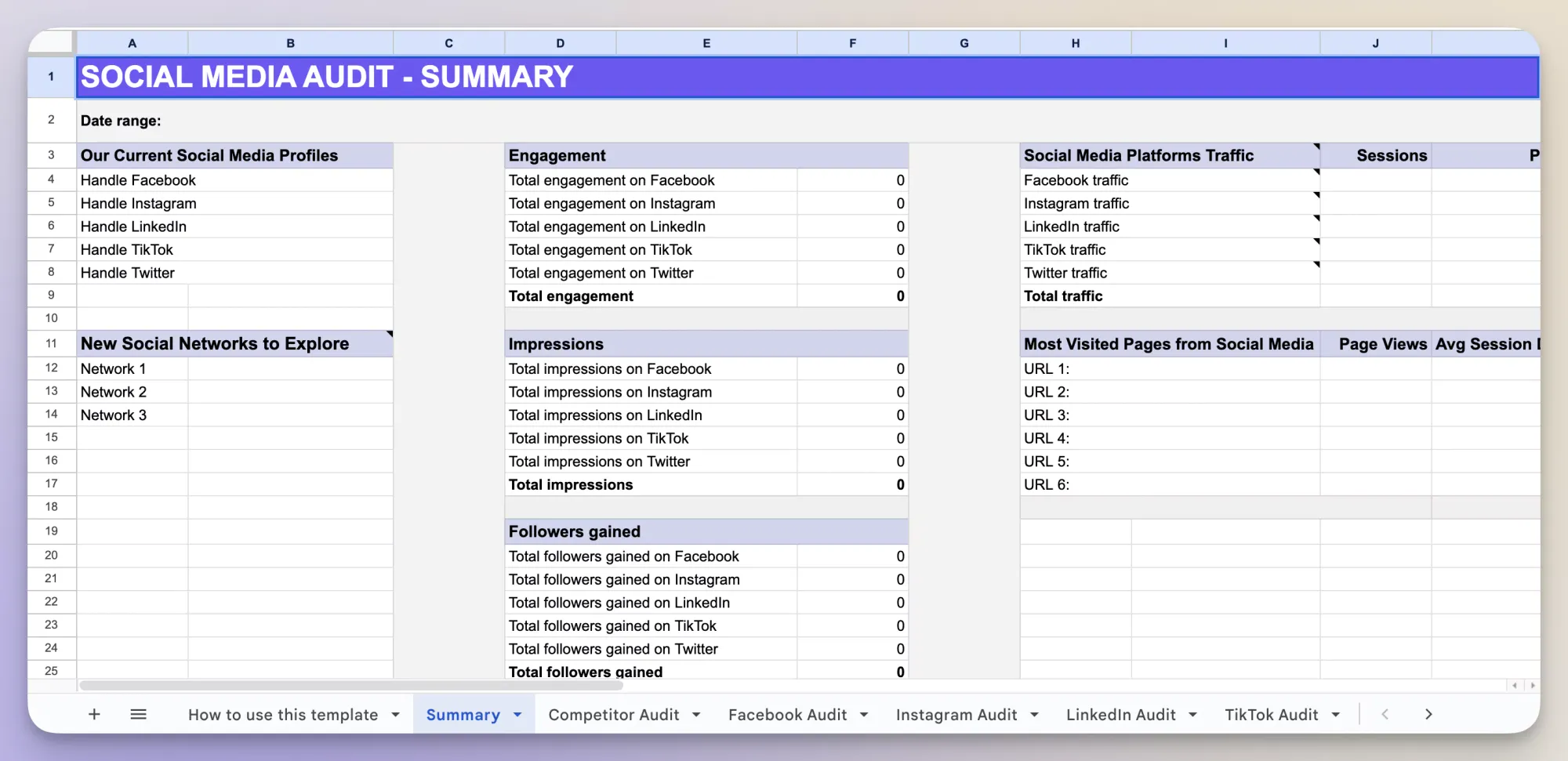
Establish how each platform can help you achieve objectives:
- Brand awareness: LinkedIn for thought leadership;
- Engagement: Instagram for company culture;
- Lead generation: Facebook for targeted campaigns;
- Education: YouTube for product demos.
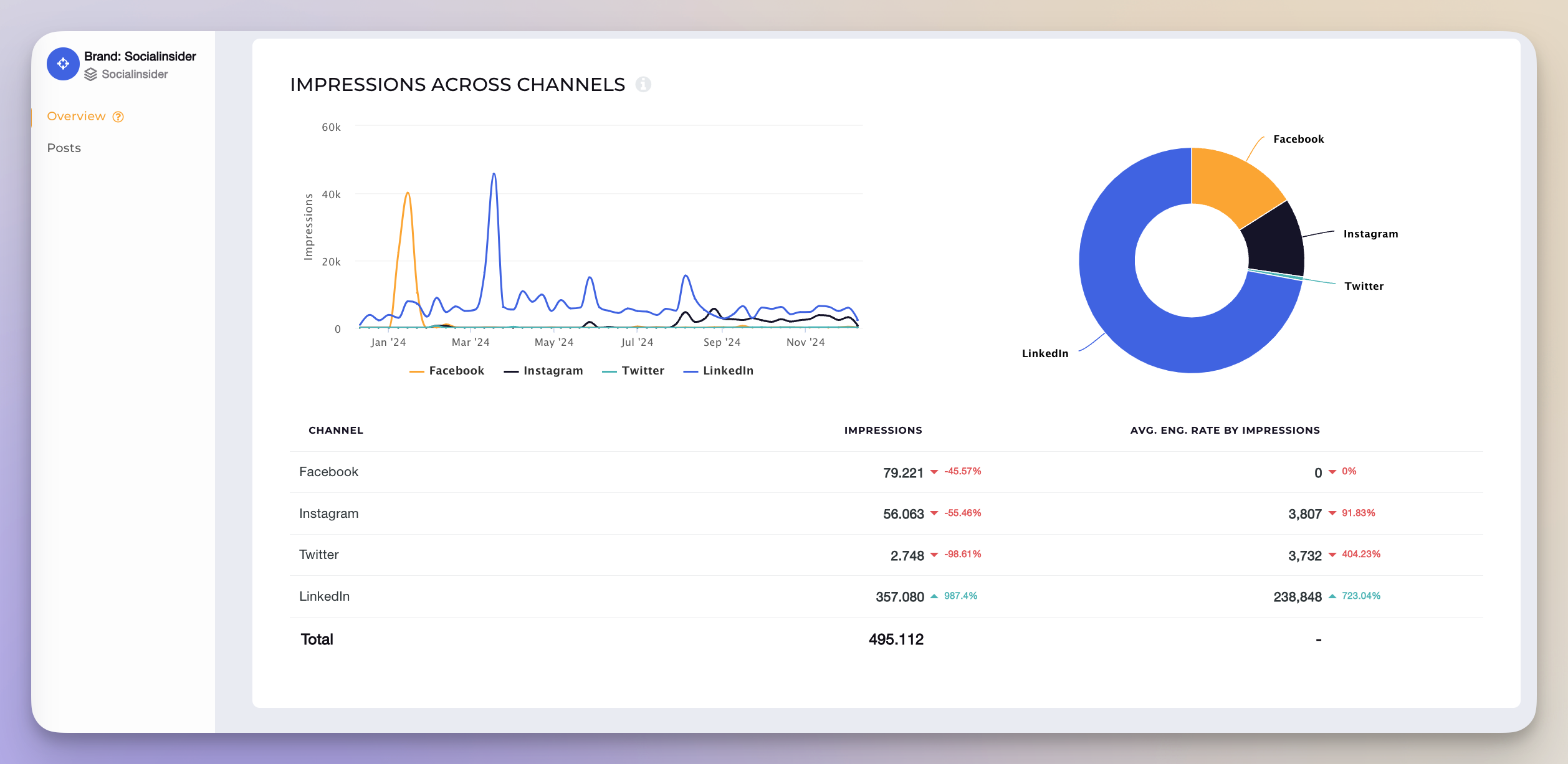
Focus your resources and efforts on platforms that yield the best outcomes:
- Choose 1-2 primary platforms and 1-2 secondary platforms;
- Align content types with platform strengths;
- Track performance monthly to understand platform performance.
Let's take our approach at Socialinsider as an example. We practice what we preach, and our choices are based on facts, not hunches.
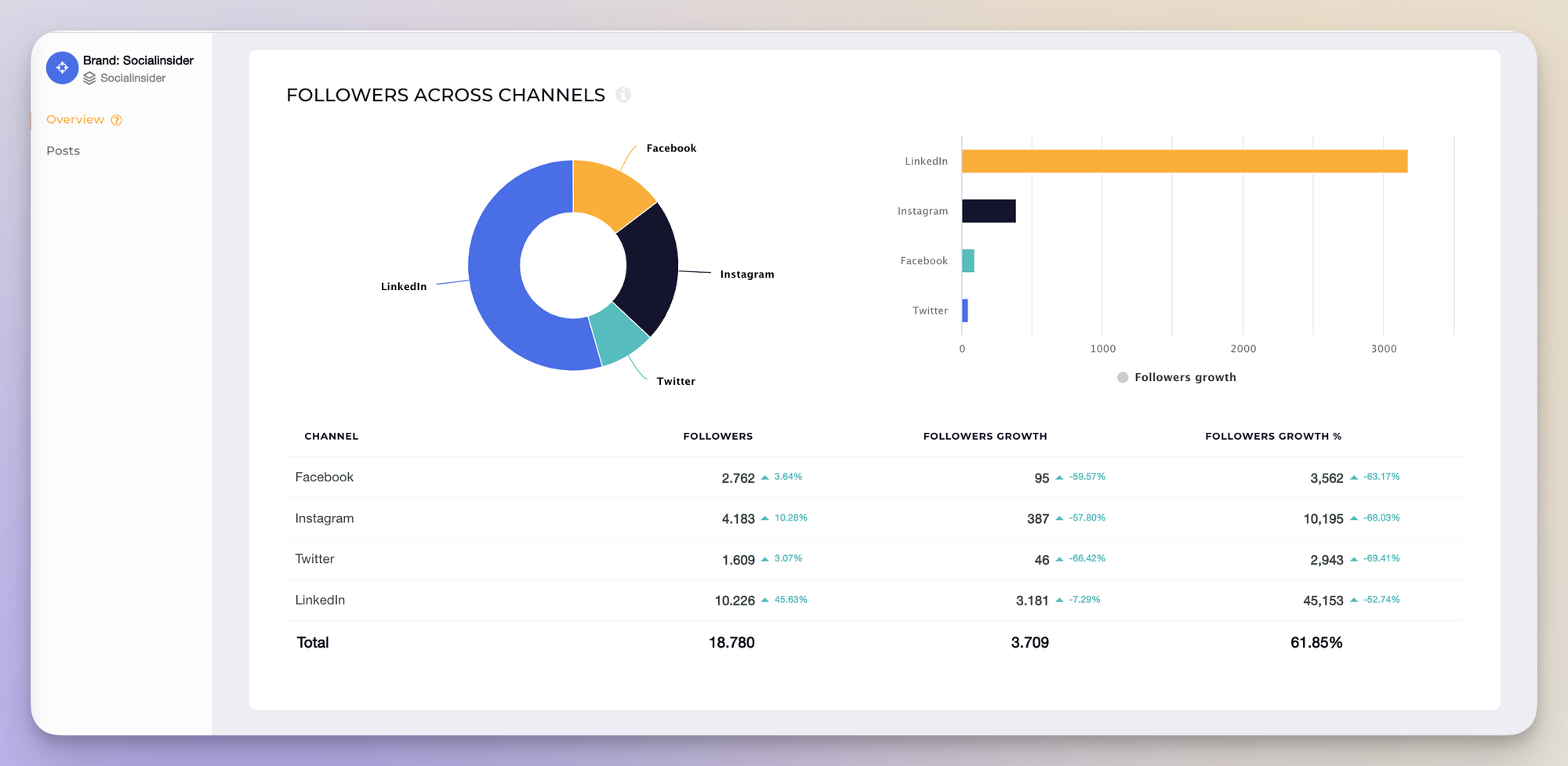
Based on a monthly analysis of performance, we chose the following platforms:
Primary platforms:
- LinkedIn: focused on brand awareness through industry insights;
- Instagram: drives customer engagement with behind-the-scenes content.
Secondary platforms:
- Facebook and X: supporting channels for additional reach.
Insider tip: Don't feel pressured to jump on every new platform because other businesses are doing it. It's better to excel on two platforms than to perform poorly on five. Use social media analytics tools to make data-driven, not FOMO-driven, decisions.
#3. Understand what your audience wants to see
Creating content your audience wants to see is a no-brainer. But how do you actually know what that is? Data, of course.
Recent research from Socialinsider reveals some fascinating insights about what people expect from brands on Instagram, for example.
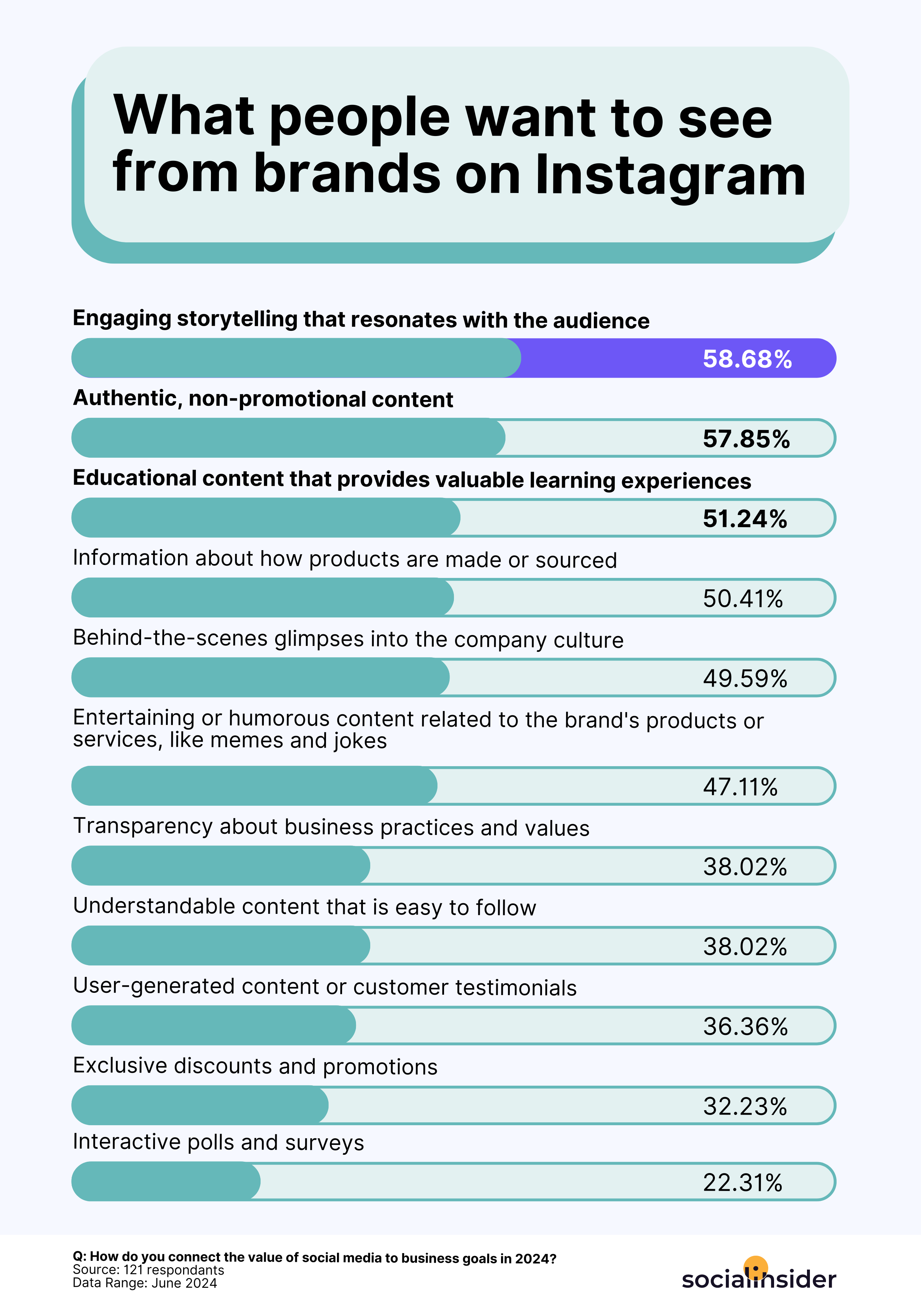
According to our study, the top three types of content people want to see are:
- Engaging storytelling that resonates with the audience (58.68%);
- Authentic, non-promotional content (57.85%);
- Educational content that provides valuable learning experiences (51.24%).
What this means for your B2B strategy:
- Focus on authentic storytelling over promotional content;
- Share behind-the-scenes glimpses into your company culture (49.59% of audiences want this);
- Create educational content that solves real problems;
- Use transparency about business practices to build trust;
- Keep content easy to understand and follow.
Interestingly, traditional marketing tactics like exclusive discounts (32.23%) and interactive polls (22.31%) ranked lowest in audience preferences, suggesting audiences value substance over promotional techniques.
Insider tip: Create a content mix that's 60% educational/storytelling, 30% behind-the-scenes, and only 10% promotional. This ratio aligns with what the data shows audiences want to see.
#4. Analyze your competitors and understand industry benchmarks
Understanding how competitors perform on various platforms helps you identify gaps and opportunities and set realistic goals for your B2B social media strategy.
To conduct a thorough competitive analysis, use Socialinsider's benchmarking feature, as it enables you to easily do the following.
Track key competitors' performance in real time:
- Compare engagement rates across platforms;
- Identify their top-performing content types;
- Monitor posting frequency and timing;
- Analyze hashtag strategies.
Gather industry insights:
- See average engagement rates for your industry;
- Identify trending content formats;
- Understand typical posting schedules;
- Benchmark your performance against industry standards.
Optimize your strategy:
- Spot gaps in competitors' content;
- Identify successful content themes;
- Learn from top-performing posts;
- Discover untapped opportunities.
Insider tip: Don't just copy what competitors do — use competitive insights to identify what's missing in your market. Sometimes, the best opportunities lie in what others aren't doing.
#5. Create original content that establishes authority
Starting from Semrush's content pillars analysis conducted with Socialinsider, as an example, we uncovered a clear pattern: thought leadership and insights are a powerful force for B2B engagement.
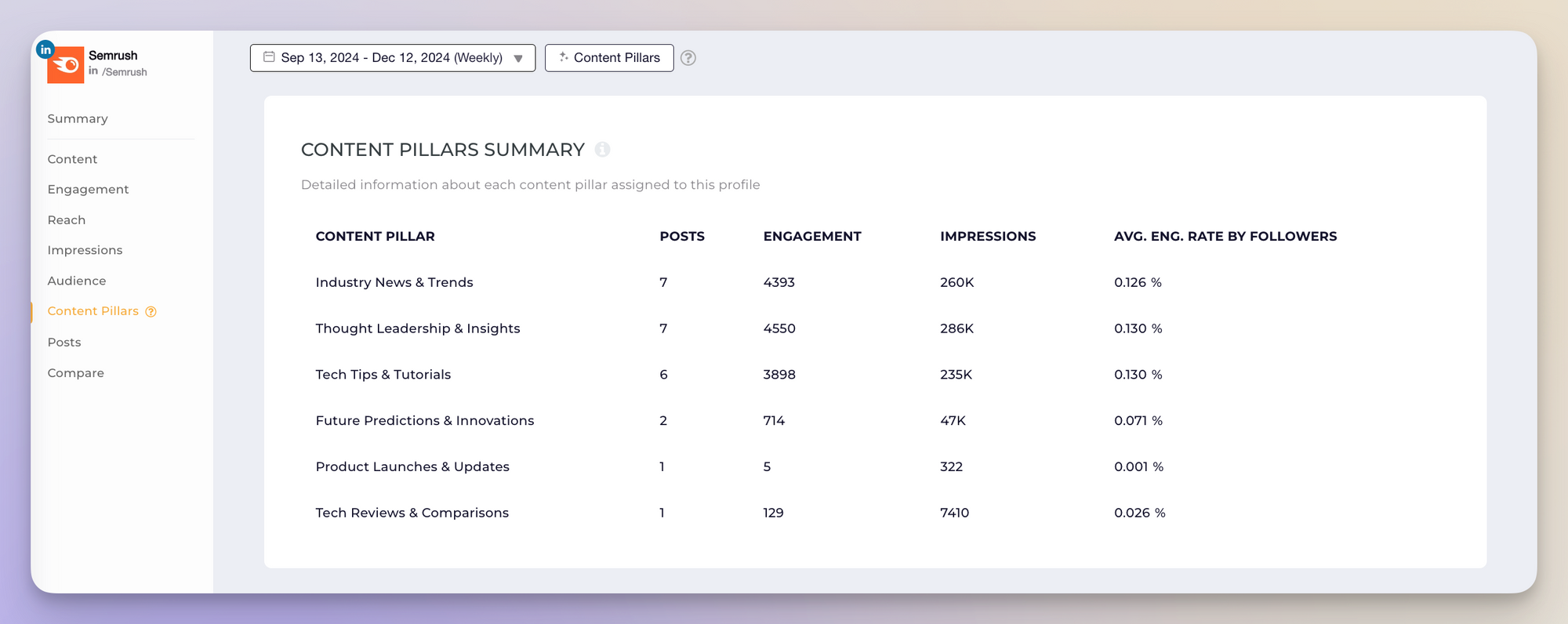
Here's how our AI content pillars feature helps optimize your B2B social media strategies.
Automatically categorizes your content performance:
- See exactly which topics drive the most engagement;
- Track impressions across different content themes;
- Compare performance across all content pillars.
Make data-driven decisions:
- The data shows which types of content drive steady engagement and impressions
Plan your content mix based on real data:
- Prioritize the content with the highest impressions — typically thought-leadership content in the B2B space;
- Balance content types according to audience preferences;
- Test new content pillars for social media with a measured approach.
Insider tip: Use the content pillars feature monthly to spot trends in your industry's engagement patterns. What worked last month might not work this one, and the data will show you these shifts before your competitors spot them, helping you stay fresh and relevant.
#6. Engage in conversations with your audience
Social media isn't just for promoting services but for building relationships through meaningful conversations.
According to a 2021 Deloitte study, B2B buyers are 34% more likely to purchase and 32% more likely to renew a contract with businesses that offer a great customer experience and have a human-centric approach.
In social media, this translates into actively participating in industry and customer discussions.
Here are a few best practices B2B social media managers should keep in mind.
Respond thoughtfully:
- Answer comments within 24 hours;
- Ask follow-up questions;
- Share additional resources when relevant;
- Tag people in relevant conversations.
Create conversation starters:
- Post thought-provoking questions;
- Share industry opinions;
- Ask for audience experiences;
- Start weekly discussion threads.
Build a community around your B2B brand:
- Create and join relevant groups and discussions;
- Share user-generated content;
- Highlight customer success stories;
- Connect industry professionals.
Insider tip: Keep a document of common questions your audience asks in the comments. These make excellent topics for future content and show you exactly what your audience wants to learn more about.
#7. Leverage employee advocacy and generated content
As highlighted in a recent Forbes article, employee-generated content (EGC) is becoming a powerful force in social media marketing.
EGC works well because it builds trust by promoting transparency and authentic views of your brand. When your employees share their experiences, they create believable human connections that traditional marketing can't match.
Here's how to develop your employee advocacy program.
Actively encourage your team to share:
- Encourage employees to share workplace experiences;
- Create behind-the-scenes content;
- Share day-in-the-life videos;
- Showcase company culture authentically.
Explain why it's beneficial for all stakeholders:
- Builds trust with authentic employee voices;
- Reduces content creation costs;
- Improves recruitment efforts;
- Strengthens brand reputation.
Make it easy to implement with clear guidelines:
- Create content posting guidelines;
- Define brand voice and values;
- Establish approval processes;
- Provide content creation training.
Insider tip: Start with your most enthusiastic team members. Their genuine excitement about your brand will naturally shine through in their content and inspire others to join the program.
#8. Create interactive content that sparks engagement
Tired of posting and seeing minimal engagement? In B2B, your social media can sometimes feel like an empty room, but it doesn't have to be that way.
There's plenty of interaction in the B2B world, you just have to learn to get your piece of the social media engagement pie — though you might have to bake it yourself.
Here's how to make your B2B content interactive.
Leverage platform-specific features that drive interaction, such as:
- Instagram Story polls and sliders;
- LinkedIn polls for industry insights;
- X spaces for live discussions;
- Facebook live Q&A sessions.
Use engaging formats, such as:
- Fill-in-the-blank posts ("Our favorite productivity tool is…");
- Industry challenges (#ShowYourDesk);
- Relatable and relevant B2B social media memes;
- "This or That" choices.
Drive meaningful interactions:
- Ask thought-provoking questions;
- Share industry predictions (and ask people to chip in with theirs);
- Create weekly engagement rituals, such as Monday Motivation or ThrowBack Thursday;
- Host live events on LinkedIn or Facebook.
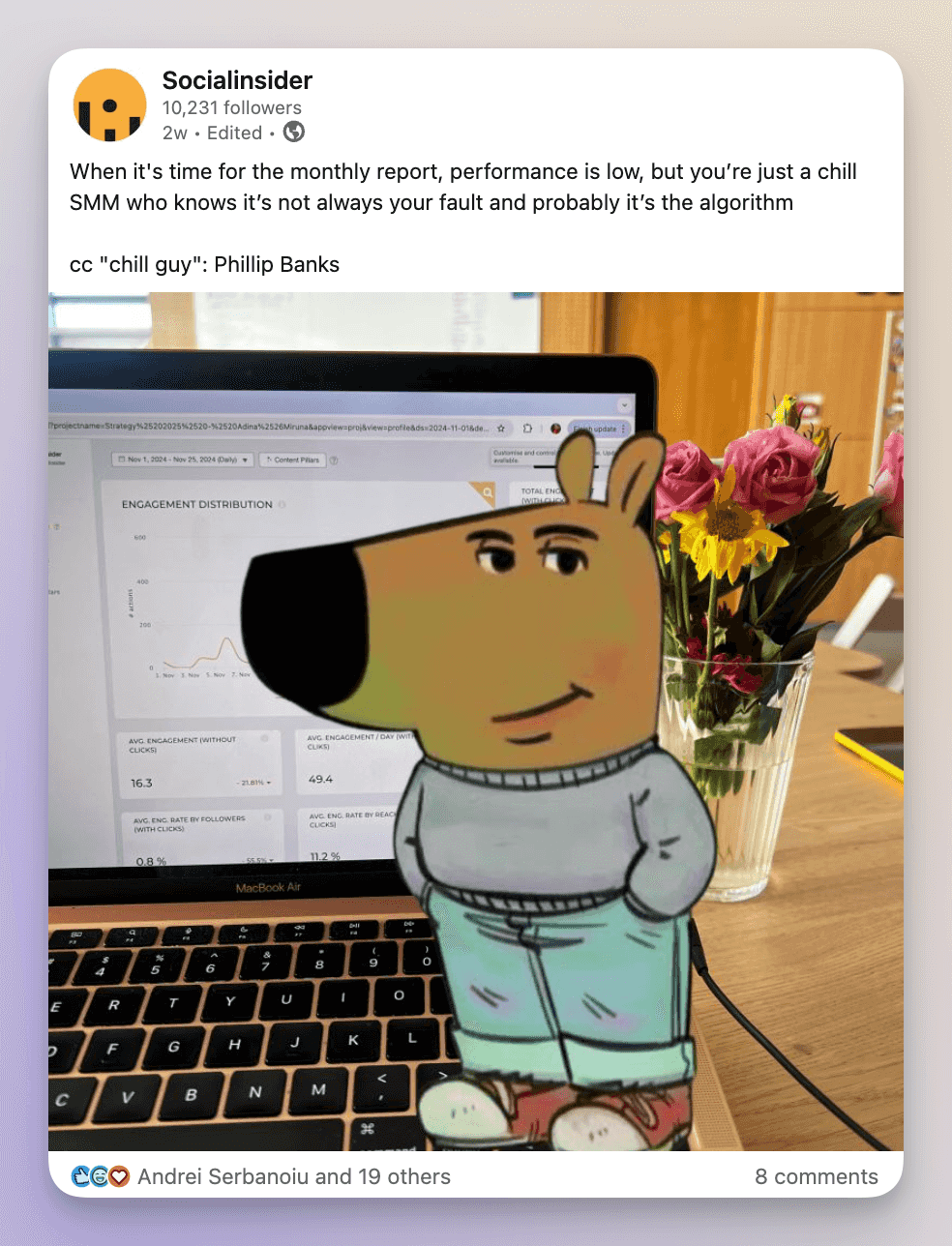
Insider tip: Track which interactive elements get the most engagement from your audience, then create templates for those formats to save time while maintaining consistency.
#9. Share authentic behind-the-scenes content
"Business to business" doesn't mean that no humans are involved. On the contrary. B2B companies are people talking to people but focusing on different pain points than B2C ones.
So, show the human side of your B2B brand.
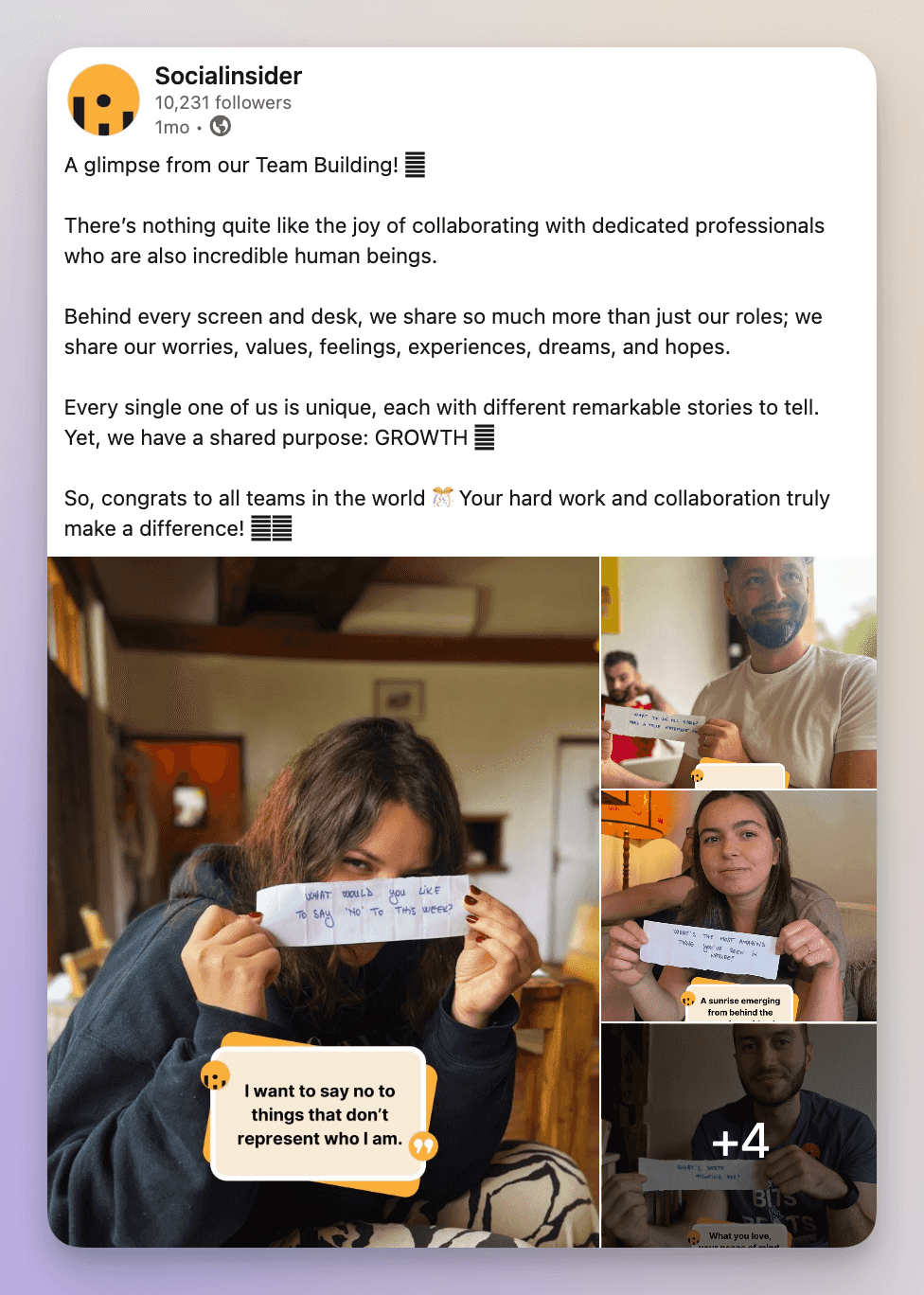
Here's how to create compelling BTS content for social media.
Document key moments:
- Product development meetings;
- Team brainstorming sessions;
- Office culture snapshots;
- Event preparations;
- Team getaways.
Show your team at work:
- Feature different departments;
- Highlight team collaboration;
- Share problem-solving processes;
- Celebrate team achievements.
Create authentic narratives:
- Tell the story behind new features;
- Share learning moments;
- Highlight employee perspectives.
Insider tip: Keep a smartphone handy during important company moments, as authentic BTS content often happens spontaneously. The less polished these shots are, the more genuine they feel to your audience.
#10. Host webinars and live events
Virtual events have become a cornerstone of B2B marketing, and for good reason. They offer direct interaction with your audience, opportunities to grow your network and lead-generation mechanisms.
In a 2022 Statista research, webinars were the top choice for generating top-of-funnel demand for 45% of B2B marketers, followed by virtual events/digital experiences (35%).
Thankfully, platforms such as LinkedIn, Facebook, and YouTube make it easy to broadcast your expertise and engage a wide audience.
A few social media best practices to know when planning B2B events.
Plan engaging sessions, such as:
- Interviews with industry top experts;
- Interactive workshops;
- Q&A sessions with company experts;
- Product features demonstrated live.
Promote live sessions effectively:
- Create event-specific landing pages;
- Share speaker highlights;
- Follow up with highlights from the event.
Insider tip: Record your live sessions and repurpose them into multiple pieces of content: blog posts, short video clips, and social media quotes.
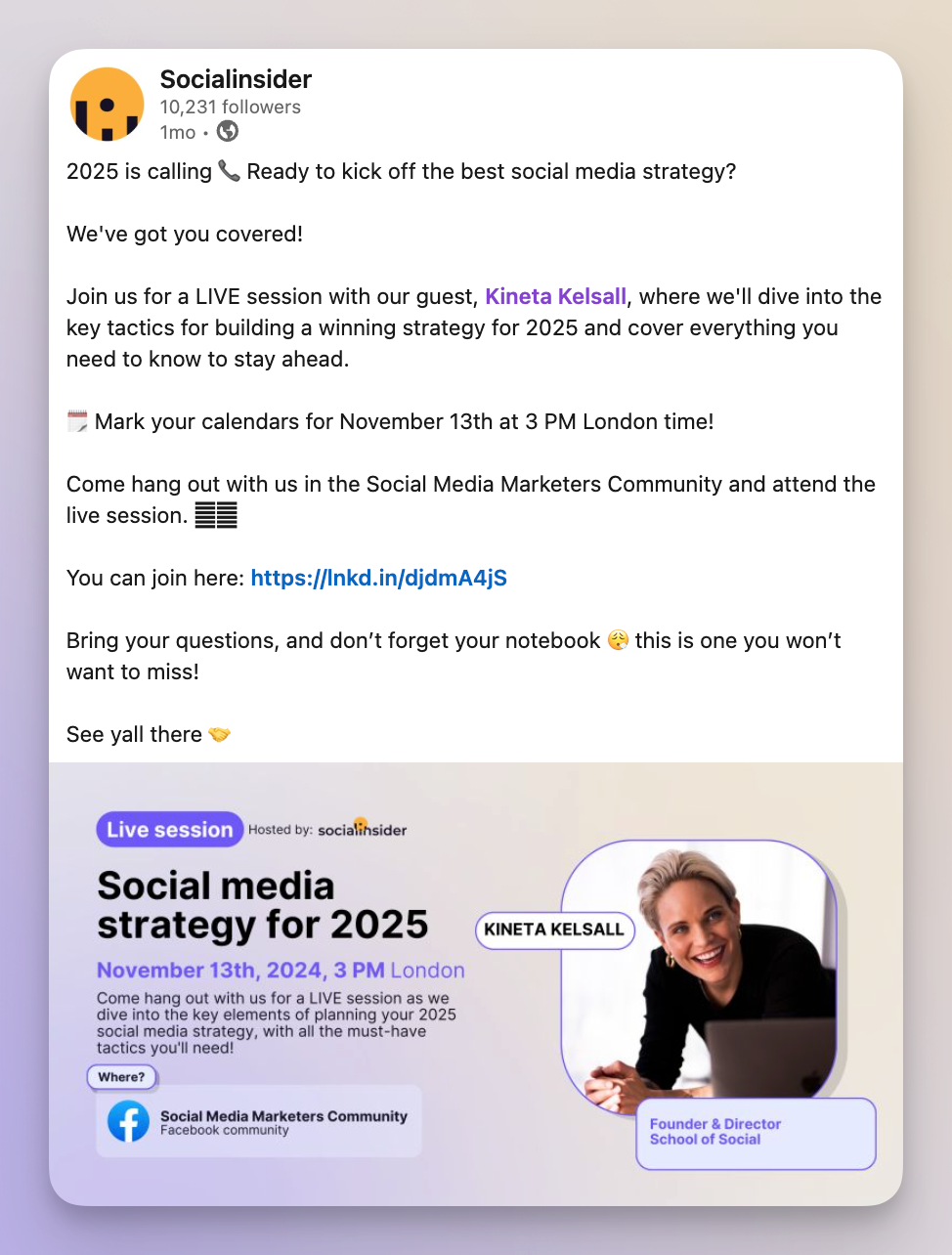
#11. Partner with B2B influencers
The B2B influencer landscape is somewhat different from B2C: think industry experts, thought leaders, and successful practitioners rather than celebrities. However, the principles remain the same.
When building influencer partnerships for B2B, consider the following.
Find the right partners that fit your brand and messaging:
- Look for subject matter experts who complement your expertise;
- Focus on industry thought leaders with significant followings;
- Consider micro-influencers in your niche who are good at engaging with their communities.
Create collaborations that are valuable for everyone involved:
- Co-create industry reports with one or several SMEs;
- Host joint webinars to extend reach and provide more value;
- Develop case studies that highlight achievements and give credit.
Insider tip: Start by authentically engaging with potential influencers' content before pitching collaboration ideas.
#12. Amplify organic content with paid ads
Your best-performing organic social media content can really take off (dare we say, go viral) by adding strategic paid promotion behind it.
In Hubspot's 2024 State of Marketing report, marketers identified paid social media as the third most important channel for generating ROI. So, make sure to include paid ads in your B2B social media strategies and optimize your budget based on results.
A few tips for optimizing paid promotions.
Select top performers from your content mix:
- High-engaging posts;
- Lead-generating content;
- Event announcements;
- Compelling case studies.
Target strategically:
- Use custom audiences on Facebook;
- Target by job titles on LinkedIn;
- Retarget engaged users on Instagram.
Analyze performance and optimize social media campaigns:
- Test different ad formats;
- Adjust targeting based on results;
- Scale successful campaigns;
- Pause underperforming ads.
Insider tip: Start with a small budget to boost your highest-engaging organic posts before creating paid-only content.
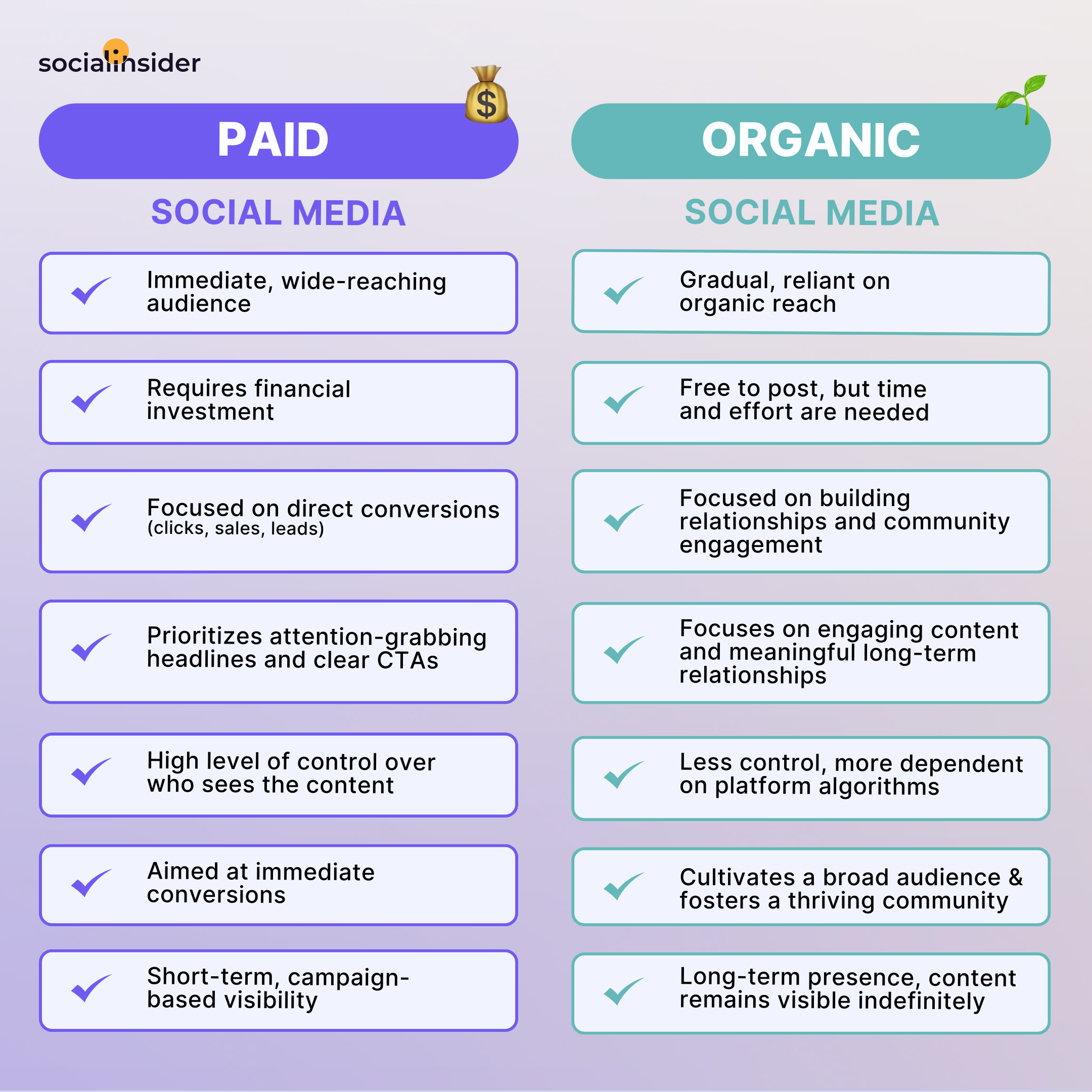
#13. Analyze and measure B2B social media performance
What gets measured gets improved. Without social media measurement, you can be wasting resources left and right, not getting results, and not knowing what to do about it.
Would you neglect to measure your business' financial performance? Of course not. The same goes for social media.
Regular analysis is crucial to understanding what's working, what's not working, and how you can refine your B2B social media strategy to maximize ROI.
Here's how to measure B2B social media efforts effectively.
Track key social media metrics, depending on your objectives:
- Engagement rates;
- Lead generation;
- Content performance;
- Follower growth.
Review social media analysis dashboards regularly:
- Set weekly, monthly, and quarterly check-ins;
- Compare results against goals;
- Make a list of actionable improvements.
Leverage technology for improved insights:
- Use social media analytics tools;
- Set up automated reporting;
- Track competitors' performance;
- Monitor industry benchmarks.
Insider tip: Create a simple weekly dashboard focusing on your top 3-5 most important metrics to make sure you're on the right track at a glance and to act quickly when something is amiss.
5 essential tools for B2B social media marketing
Speaking of the importance of analysis in your B2B strategy, let's look at the tools that can help you implement B2B social media strategies effectively and measure your success.
Socialinsider
Socialinsider is the complete solution for any B2B social media manager looking to understand performance, generate insightful reports, and optimize performance.
Beyond basic metrics, Socialinsider provides AI-powered content analysis, industry benchmarks, and detailed competitor insights.
The platform is particularly valuable for its content pillar analysis and competitive benchmarking features, which help you understand not just how your content performs but why it performs that way.
The depth of social media insights, coupled with its ease of use, make it a must-have for B2B brands looking to have a successful online presence.
#2. Salesforce for CRM
Salesforce provides a powerful CRM that helps track how your social media leads move through your sales funnel.
The platform offers social media integration and comprehensive reporting capabilities.
However, it can be expensive for smaller businesses and the vast array of features means you might not use everything you're paying for. It's best suited for medium to large enterprises with complex sales processes.
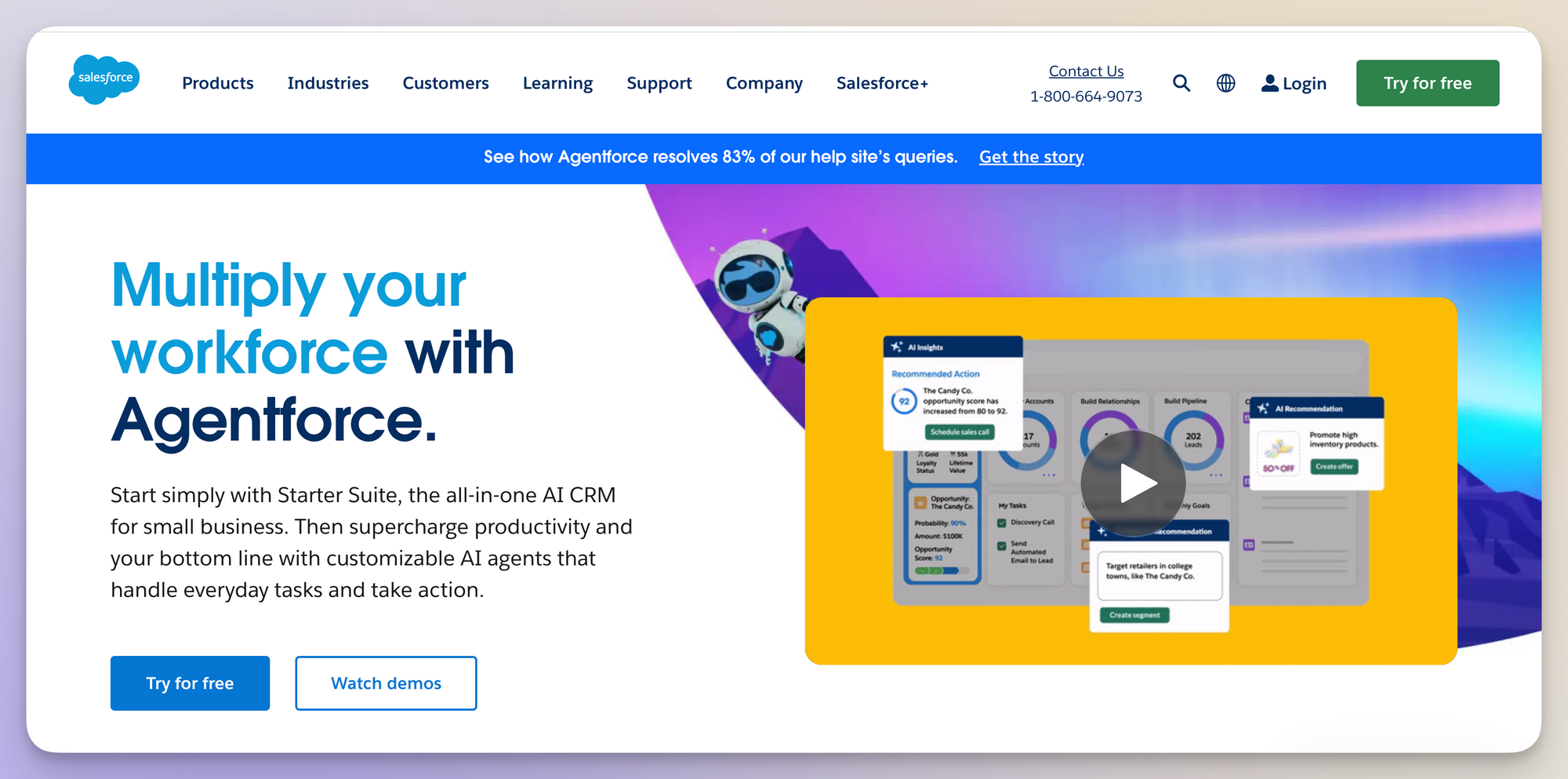
#3. HypeAuditor for influencer management
HypeAuditor is a specialized tool for finding and managing B2B influencer partnerships. It helps verify authentic industry experts and measure collaboration results.
The tool stands out for its fraud detection and audience quality metrics, which are crucial for B2B, where authenticity matters more than follower count.
The main drawback is its B2C-centric approach, though the platform is moving more and more towards B2B and adapting to include more specific metrics and features.
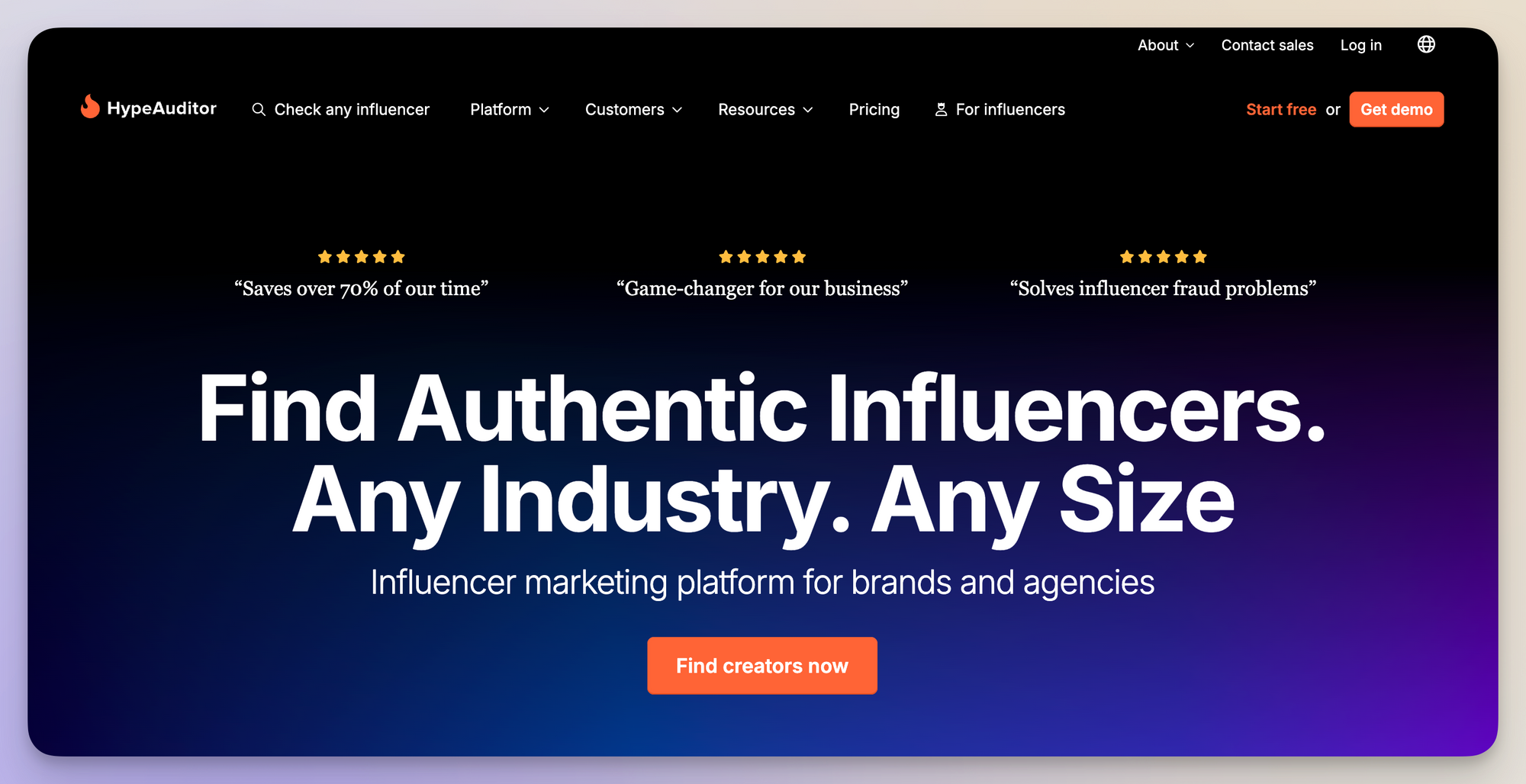
#4. Planable for social media content collaboration
Planable streamlines social media content collaboration and distribution. The platform makes it easy to plan, review, and schedule content across multiple social media platforms.
B2B social media managers appreciate its intuitive interface and excellent approval workflows, which make it ideal for teams with multiple stakeholders.
The platform is focused mainly on content planning and distribution, though it offers some analytics features as well.
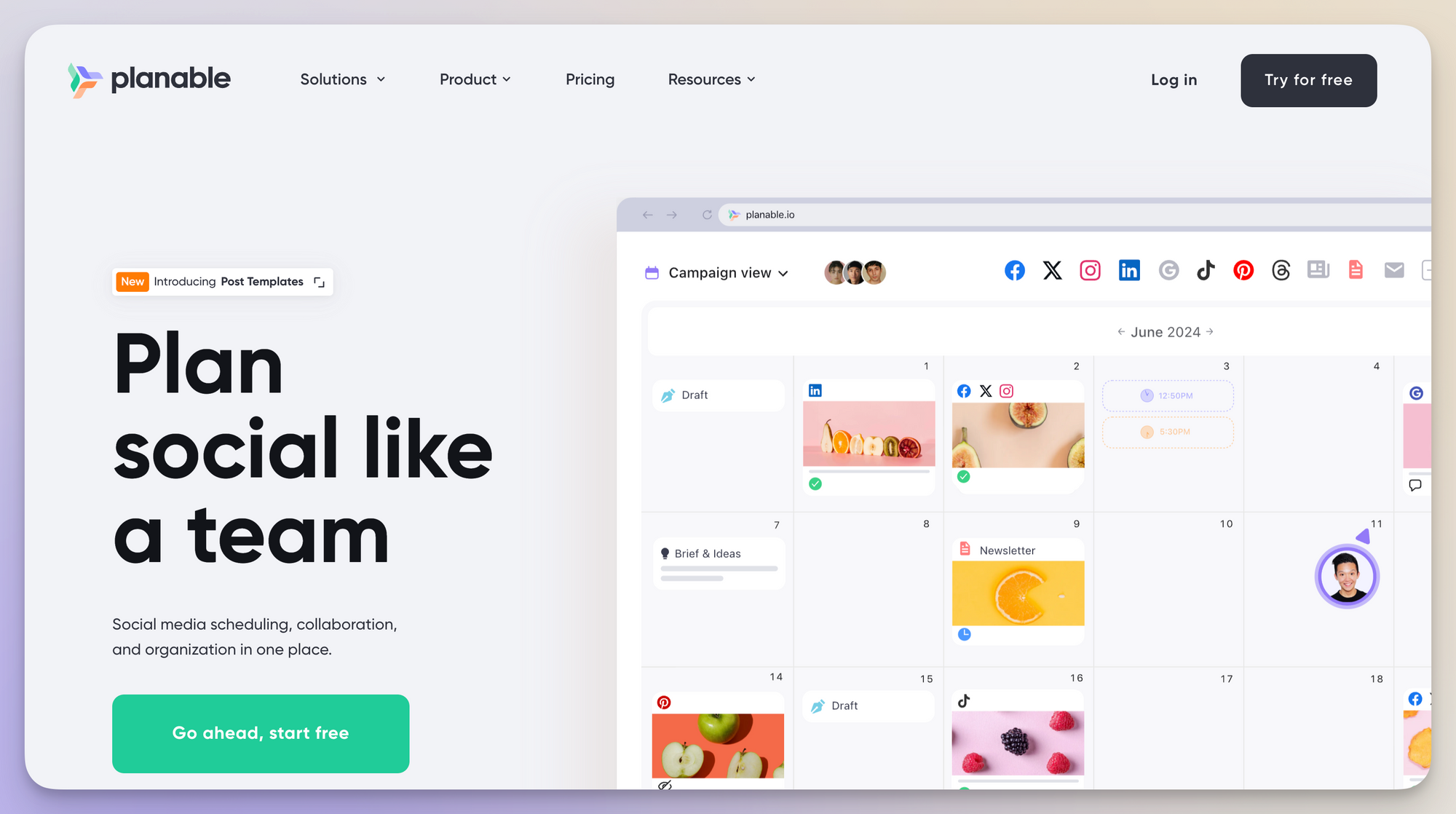
#5. Databox for marketing dashboards
Databox enables users to create customizable marketing dashboards that combine data from multiple sources, helping them track the most important social media KPIs alongside other marketing metrics.
The tool excels at creating visually appealing, real-time dashboards that make reporting easier.
Keep in mind that you'll need to invest time in creating the right dashboard templates and ensuring accurate data connections, though the platform provides some pre-built templates and integrations that reduce setup time.
Insider tip: Most of these tools offer free trials or limited free plans. Test them with your actual workflow before committing to ensure they meet your specific needs.
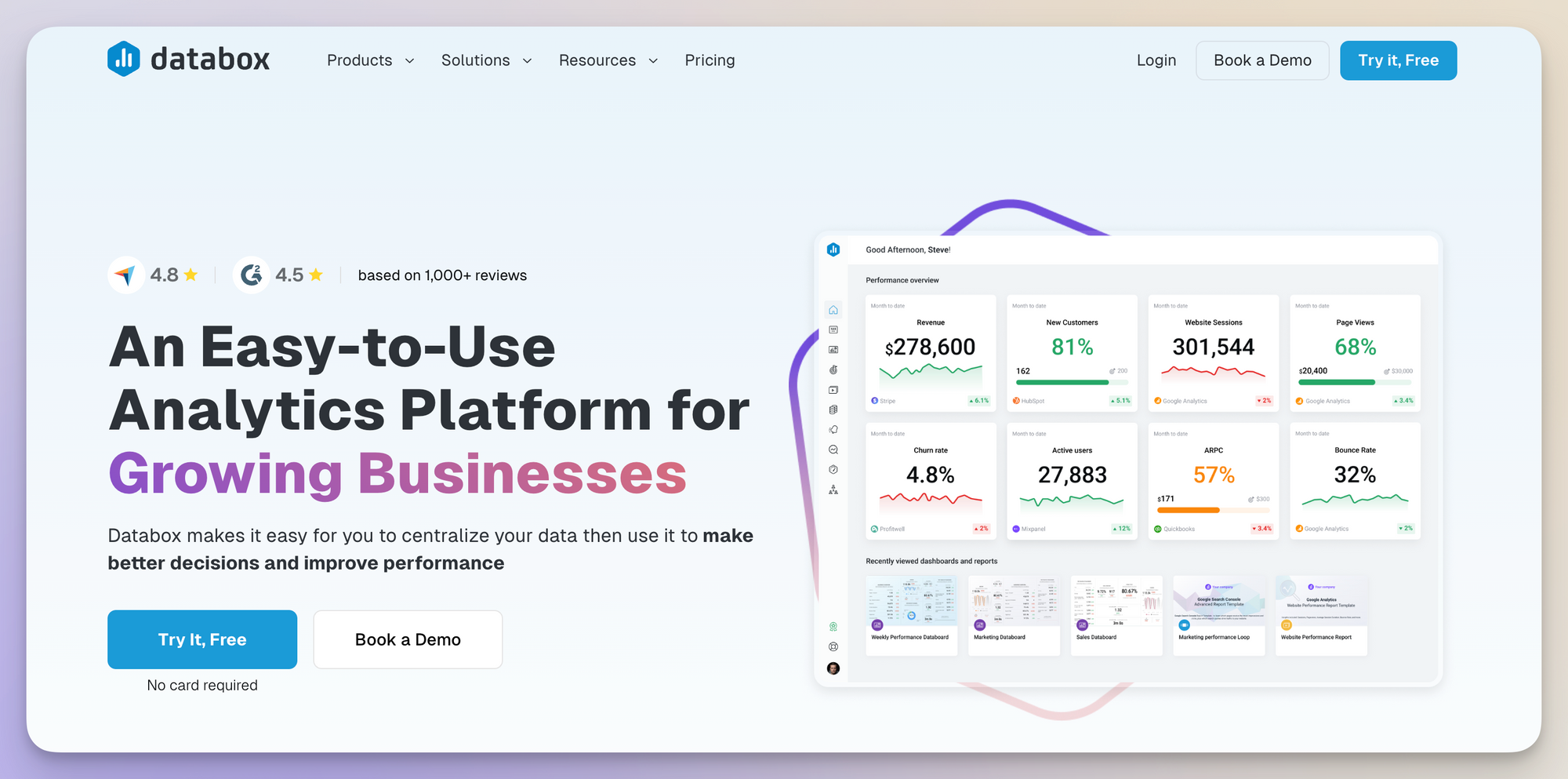
Final thoughts
B2B social media marketing doesn't have to be complicated or overwhelming. With the right strategy, tools, and consistent effort, you can build a strong social media presence that generates quality leads and establishes your brand as an industry leader.
Ready to transform your B2B social media strategy through data? Try Socialinsider free for 14 days and discover how insights can boost your social media performance.
FAQs on B2B social media marketing
Why is LinkedIn important for B2B?
LinkedIn stands out as the most effective B2B social media platform. It's where business decision-makers actively engage with content, particularly thought leadership posts and industry insights. According to LinkedIn benchmarks, professional content like technical tutorials and industry trends generate the highest engagement rates on this platform, helping brands get more awareness, reach, and conversions.
Why use social media for B2B marketing?
B2B audiences want to see authentic, educational content from brands. Through social media, you can share thought leadership content, behind-the-scenes glimpses of your company, and valuable industry insights. Social platforms help you build relationships through employee advocacy, interactive content, and direct engagement with decision-makers.
How to use social media for B2B marketing?
Start by identifying your target audience and choosing the right platforms (primarily LinkedIn). Focus on creating valuable content that educates and solves problems. Engage consistently with your audience, share thought leadership content, and use analytics to refine your strategy. Consider a mix of organic content and paid advertising to reach decision-makers effectively.
Which social media platform is best for B2B marketing?
LinkedIn leads as the most effective B2B platform, but a multi-channel approach often works best. Consider the following platforms:
- LinkedIn for professional networking and lead generation;
- Instagram for brand storytelling and company culture;
- Twitter for industry news and real-time engagement;
- YouTube for in-depth product demonstrations and educational content.
How to do B2B social media marketing effectively?
If you're looking for a B2B social media marketing template, follow these key steps:
- Set clear business objectives;
- Choose appropriate platforms;
- Create valuable, educational content;
- Engage with your audience consistently;
- Use analytics to measure and improve;
- Combine organic and paid strategies;
- Focus on building long-term relationships rather than quick sales.
Analyze your competitors in seconds
Track & analyze your competitors and get top social media metrics and more!
You might also like
Improve your social media strategy with Socialinsider!
Use in-depth data to measure your social accounts’ performance, analyze competitors, and gain insights to improve your strategy.

